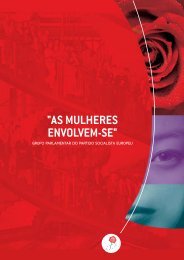Politics of the past: the use and abuse of history - Socialists ...
Politics of the past: the use and abuse of history - Socialists ...
Politics of the past: the use and abuse of history - Socialists ...
Create successful ePaper yourself
Turn your PDF publications into a flip-book with our unique Google optimized e-Paper software.
ians to evaluate <strong>the</strong> extent to which assertion <strong>of</strong> <strong>the</strong> <strong>of</strong>ficial ‘idea <strong>of</strong><br />
<strong>the</strong> Hungarian state’ in political practice formed <strong>the</strong> Magyar nation’s<br />
relationship to non-Magyar nations living inside <strong>the</strong> old Hungary<br />
<strong>and</strong> also to ethnic minorities living in <strong>the</strong> post-1918, reduced<br />
Magyar state.<br />
I shall attempt to outline briefly <strong>the</strong> changing fortunes <strong>of</strong> Slovak historical<br />
argument, or arguments, which did not end with <strong>the</strong> demise<br />
<strong>of</strong> <strong>the</strong> old Hungary in 1918, but continued during <strong>the</strong> period <strong>of</strong> <strong>the</strong><br />
two Czechoslovak states (1918 - 1939 <strong>and</strong> 1945 - 1992) <strong>and</strong> <strong>the</strong><br />
wartime Slovak state, <strong>and</strong> still persist today in <strong>the</strong> Slovak Republic,<br />
founded in 1993.<br />
When considering <strong>the</strong> historical arguments <strong>of</strong> Slovak scholars in<br />
<strong>the</strong> old Hungary, <strong>the</strong> vital point is that in <strong>the</strong> Middle Ages <strong>the</strong> Slovak<br />
ethnic group was not a separate national Estate, ‘natio slavica’;<br />
<strong>the</strong> ethnic Slovak nobility always formed part <strong>of</strong> <strong>the</strong> Hungarian,<br />
or Magyar, national Estate, <strong>and</strong> in <strong>the</strong> modern era, especially <strong>the</strong><br />
19 th century, <strong>the</strong> great majority <strong>of</strong> Slovak aristocrats assimilated –<br />
Magyarized – thus linking <strong>the</strong>ir fate with that <strong>of</strong> <strong>the</strong> modern Magyar<br />
nation. And when, politically, economically <strong>and</strong> culturally, <strong>the</strong> <strong>history</strong><br />
<strong>of</strong> <strong>the</strong> Hungarian national aristocratic Estate began to be perceived<br />
as <strong>the</strong> <strong>history</strong> <strong>of</strong> <strong>the</strong> Magyar civic nation, <strong>the</strong> Slovaks<br />
remained, as it were, outside <strong>history</strong> – even though in fact <strong>the</strong>y<br />
shared historical experience with <strong>the</strong> o<strong>the</strong>r inhabitants <strong>of</strong> Hungary.<br />
The few 19 th -century Slovak historians unintentionally linked <strong>the</strong>mselves<br />
with this ‘<strong>history</strong>lessness’, since <strong>the</strong>y highlighted as ‘Slovak’<br />
only certain epochs in <strong>the</strong> thous<strong>and</strong>-year existence <strong>of</strong> Slovaks in<br />
<strong>the</strong> Hungarian state. So <strong>the</strong> <strong>history</strong> <strong>of</strong> <strong>the</strong> Slovaks lost any clearly<br />
visible continuity, which is an important factor contributing to <strong>the</strong><br />
effect <strong>of</strong> <strong>history</strong> on <strong>the</strong> formation <strong>of</strong> national identity, <strong>and</strong> became a<br />
kind <strong>of</strong> ‘underground stream’. We see it come to <strong>the</strong> surface again<br />
chiefly in relation to <strong>the</strong> beginnings <strong>of</strong> Slovak <strong>history</strong>, especially <strong>the</strong><br />
9 th century (in <strong>the</strong> period <strong>of</strong> <strong>the</strong> Great Moravian Empire – that is, before<br />
<strong>the</strong> Kingdom <strong>of</strong> Hungary was established); it <strong>the</strong>n ‘waxes rhapsodic’<br />
about <strong>the</strong> Hungarian Middle Ages <strong>and</strong> <strong>the</strong> Early Modern<br />
period; it was rediscovered on <strong>the</strong> threshold <strong>of</strong> <strong>the</strong> Modern period,<br />
at <strong>the</strong> end <strong>of</strong> <strong>the</strong> 18 th century, <strong>and</strong> has remained continuously visible<br />
up to today. And it was only with difficulty that this interpretation<br />
<strong>of</strong> <strong>history</strong> became a solid constituent pillar <strong>of</strong> Slovak national<br />
identity.<br />
176





